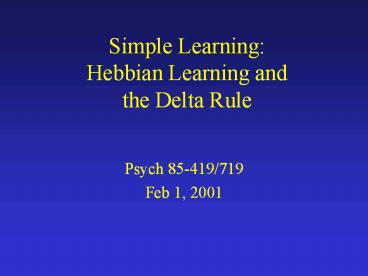Simple Learning: Hebbian Learning and the Delta Rule - PowerPoint PPT Presentation
1 / 16
Title:
Simple Learning: Hebbian Learning and the Delta Rule
Description:
Cannot solve problems that are not linearly separable (e.g., XOR) a b -1 -1. 1 -1 -1 1 ... 9 of PDP1 (a brush up on linear algebra) Homework #2 handed out ... – PowerPoint PPT presentation
Number of Views:1647
Avg rating:3.0/5.0
Title: Simple Learning: Hebbian Learning and the Delta Rule
1
Simple LearningHebbian Learning andthe Delta
Rule
- Psych 85-419/719
- Feb 1, 2001
2
Correlational Learning
- Suppose we have a set of samples from some domain
were interested in. - People in this class age, height, weight, etc.
- The set of variables (e.g., age, weight) is a
vector of numbers (22, 30, 19), (175, 130, 200) - We can compute the correlation between any of
those vectors. Can predict one variable from
another.
3
In Statistics...
We gather samples
250
We can use a regression to predict one variable
from another
weight
For novel instances, use regression line to
guess what predicted variable is.
100
48
84
height
4
Learning
- Decomposability of the problem treat each output
unit as a simpler problem to solve
So how do we update the weights from input units
to outputs?
5
The Hebb Rule
- The change in weight from unit i to j is the
product of the two units activities, and a
scaling factor u - If both units activities are positive, or both
negative, weight goes up - If signs are opposite, weight goes down
j
wi,j
i
6
Example ca (u0.25)
-1 -1
-1
.25 .25
.25 -.25
1
1 -1
-1
.25 -.25
-1 1
1
.25 .25
1 1
1.0 0.0
7
A Failure ca or b
-1 -1
-1
.25 .25
.25 -.25
1
1 -1
-.25 .25
1
-1 1
1
.25 .25
1 1
0.75 0.75
8
With Biases d a or b (unit c as bias unit)
-1 -1 1
-1
.25 .25 -.25
.25 -.25 .25
1
1 -1 1
-.25 .25 .25
1
-1 1 1
1
.25 .25 .25
1 1 1
0.75 0.75 0.75
9
A Real Failure
1 -1 1 -1
1
.25 -.25 .25 -.25
1
.25 .25 .25 .25
1 1 1 1
-1
-.25 -.25 -.25 .25
1 1 1 -1
-1
-.25 .25 .25 -.25
1 -1 -1 1
0.0 0.0 0.75 0.0
10
Properties of the Hebb Rule
- What if unit outputs are always positive?
- What happens over a long period of time?
- Doesnt always work (even if solution exists).
- The essential problem weight value is only a
function of behavior of units it connects.
11
Something More SophisticatedThe Delta Rule
- Weight change a function of activity in the from
unit (unit j), and the error, e on the to unit i. - This means weight updates are implicitly a
function of the overall network behavior
12
The Failure Revisited
e
x
Dw4
Dw1
Dw2
Dw3
a
c
b
d
1
1 -1 1 -1
1
.25 -.25 .25 -.25
1
1
.25 .25 .25 .25
1 1 1 1
-2
-1
-.5 -.5 -.5 .5
1 1 1 -1
-2
-1
-.5 .5 .5 -.5
1 -1 -1 1
-.5 0.0 0.5 0.0
And so on.
13
Properties of the Delta Rule
- Can be proven that it will converge to the weight
vector that produces the global minimum possible
sum squared error between targets and outputs.
14
Proof...
15
Limitations
- Cannot solve problems that are not linearly
separable (e.g., XOR)
Im going to a Penguins game on Monday or
Wednesday.
Implies that Im not going to BOTH games!
16
Next Class Pattern Association
- Read handout
- And Chapter 11 of PDP1
- Optional read Chapter 9 of PDP1 (a brush up on
linear algebra) - Homework 2 handed out































